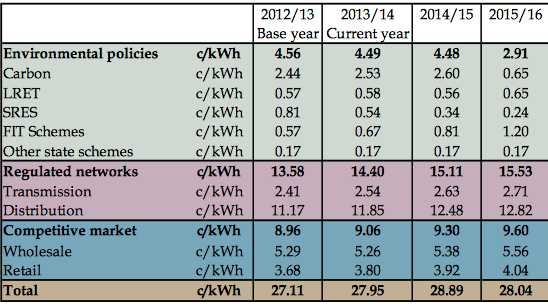1. Radical ideas for renewable energy policy
Investment bank UBS came up with this list:
1. Mandate time of use meter roll out over remaining States in the NEM (NSW, QLD, SA, TAS)
2. Reinstate the carbon tax with zero exemptions and zero compensation, but start it at a lower level, say $10/t. This would raise around $5bn of revenue and continue to discourage electricity consumption. It would send a price signal to all carbon producers, however of itself it would not induce much fuel shifting.
3. Encourage the construction of distributed PV solar on any building where the majority of the electricity consumption is during the day or where the costs of being connected to the grid are high. Examples of the former category include many Federal and State Government owned buildings, factories and warehouses. All that flat Western Sydney metal roofing is ideal for solar.
4. We would use some of the funds raised to subsidise the take-up of onsite storage and encourage grid defection and the creation of micro grids, particularly in rural areas. Network investment and pricing models would need to be sharply revised.
5. Networks in general would have their monopoly pricing status revoked. In the world of the “Nu-tility”, the network is no longer a monopoly – it competes with distributed electricity and possibly with other distribution business models. If networks put prices up too much they will face competition of their own.
6. We would incentivise closure of some brown coal fired electricity in Victoria, possibly via means of environmental regulation, but possibly with a capacity closure auction.
7. Likely continue with the current renewables target.
I can’t say I like all of these but they are a starting point for discussion. The article also had this table comparing renewable and fossil “subsidies”. (Excluding state subsidies which are quite significant.)

2. Queensland power price goes negative in the middle of the day
Last week, for the first time in memory, the wholesale price of electricity in Queensland fell into negative territory – in the middle of the day. For several days the price – normally around $40-$50 a megawatt hour – hovered in and around zero. Prices were deflated throughout the week.
There were several reasons for this. A restricted interconnector to NSW added to the volatile trading, as did uncertainty about the carbon price. But the overall softening of prices was primarily the result of the newest and one of the biggest power stations in the state – rooftop solar PV.
There is 1,100MW of it on more than 350,000 buildings in Queensland alone (3,400MW on 1.2 million building across the country), and it is producing electricity just at the time that coal generators used to make hay (while the sun shines).
The article also had this table showing just how large the grid owners and retailers are costing consumers.

3. Solar fuels exports from the Pilbara
This article argues that the Japan free trade agreement may hasten the production of solar fuels from the Pilbara. A key argument is based around Japanese fears of LNG supplies being exposed to deteriorating relationships with China (as well as price uncertainty.)
Liquid ammonia is the logical solar fuel for production in the Pilbara. Renewable ammonia can be produced from renewable power, water and nitrogen from the air. Theoretical water consumption is 1.6 litres water per kg of ammonia so this shouldn’t be a problem even if desalination is required. (Other solar fuels such as gasoline require a source of CO2)
Liquid ammonia could be transported using LNG facilities. The big disadvantage of liquid ammonia is that one kg of LNG has the same energy as 2.9 kg of liquid ammonia. However, to some extent this disadvantage will be off set by the fact that ammonia can be used in fuel cells.
4. Turkey nest dams may be key to pumped storage in Australia
This article argues that “off river pumped storage” using small turkey nest dams overcomes the problems of using pumped storage systems with the dams in river valleys.
Off-river electricity storage has several advantages over typical on-river facilities:
– There are vastly more potential sites
– Sites can be selected that do not clash with environmental and other values
– The upper reservoir can be placed on top of a hill rather than in a valley, allowing the elevation difference to be maximised
– No provision needs to be made for floods (typically a major cost).
A system comprising twin 10ha reservoirs, each 30m deep, with a 750m elevation difference, can deliver about 1000 megawatts for five hours.
Between 20 and 40 of these systems would be enough to stabilise a 100 per cent renewable Australian electricity system.
How much does it cost?
As the reservoirs are tiny (just a few hectares) compared with typical hydro reservoirs, they are a minor component of the cost. Most of the cost is in the power components (pipes, pumps, turbines, transformers and transmission). Initial estimates suggest that the cost of an off-river system at a good site is around $1000 per kilowatt of installed capacity.
One m3/sec of water falling one m will generate 9.807 kW





